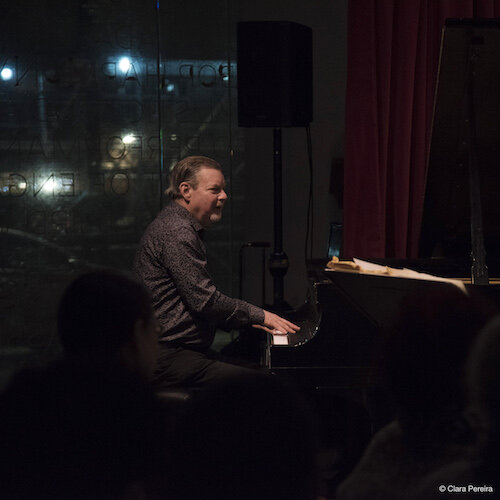By Filipe Freitas
Frank Kimbrough, 2019 ©Clara Pereira
Name: Frank Kimbrough
Instrument: piano
Style: post-bop, modern creative
Album Highlights: Play (Palmetto, 2006), Solstice (Pirouet, 2016), Monk’s Dreams (Sunnyside, 2018)
In October you’re going to play at AngraJazz with your quartet. Did you hear about this festival before? How did the invitation come up?
I played there in 2004 with the Herbie Nichols Project. Maybe that was part of a tour, I can’t even remember at this point. It was quite a few years ago, but I remember we had a beautiful time. The island is beautiful! I remember going up to the rim of the volcano and I remember the food! (laughs). Miguel Cunha [AngraJazz artistic director] sent me an email maybe two or three months after the release of the 6-CD box set album Monk’s Dreams. I called the guys to see if they could do it and everyone was available, so here we go.
What attracts you the most in the music of Monk to the point of recording his complete repertoire?
I always loved his music, but when I was young I did’t really get it. And then, one day when I was in my mid twenties, I was listening to some of his music and all of a sudden I realized it was great. So, I love his music and I’ve been playing a lot of his tunes over the years. I played a concert at Jazz Standard with this band to celebrate Monk’s 100th birthday and an old friend of mine, who used to go see Monk playing with Coltrane at the Five Spot Café when he was young, was there and liked it. So, he came to me at the break and said: “think about this, maybe you can take this band to the studio and record everything that Monk wrote”. We had a conversation a few days later about this, and he and a friend of his funded the whole thing. That was what enabled us to do it.
What other main influences are brought into your playing?
I have many, many influences but the people I was closest personally were Andrew Hill, Paul Bley, and Shirley Horn, and later on Paul Motian. They were all very kind to me and we’ve spent a lot of time together. So, their influence was not just musical. I observed how they worked and we spent time talking about music but other things too. They are my main influences.
What made you choose Scott Robinson, Rufus Reid and Billy Drummond for this particular project?
Scott and I have known each other for almost 40 years and we played our first gig together in 1980. I’ve always admired Scott’s playing, and when I started thinking about the project, the only person I thought would be perfect for this was Scott. That’s what I was hearing in my head, so I called him. I’ve worked with Rufus in different contexts before and I can almost hear him playing with Monk. He played with Andrew too, at least on one or two records, I think. I’ve always loved Rufus, he’s such a sweet and smart person and he plays so beautifully. And the same with Billy, you know, I love these guys and everybody is so easy to work with. Everybody is so creative and, at the end of the day, it’s like four friends having a conversation.
What are your top 3 jazz records?
That’s very difficult! But I can tell you the record that made me decide to be a jazz musician. It was Four & More by Miles Davis. I heard that when I was maybe 18 years old and it just completely blew my mind.
Do you listen to other genres besides jazz?
Yes. Let me look at my media player and I can tell you a few names. There’s a lot of jazz here: Ornette, Mingus, Andrew [Hill], and Weather Report, but also Elis Regina, Maria Bethania, Hermeto Pascoal, the French composer Messiaen, I have some Tom Waits, there’s this Spanish composer Federico Mompou that I like a lot. I also listen to Baweanese music and shakuhachi music from Japan. I just don’t listen to a lot of pop music. Most of the time, I tend to go to more introspective music but I try to listen to a lot of different things.
Is there someone whom you’ve never collaborated with but you’d like to?
Oh! And they have to be alive, right? (laughs). I think it would be really fun to play with Andrew Cyrille. Also… Roscoe Mitchell.
Which do you prefer, studio recording or live performance?
That’s a tough one. A lot of times, pianos can be a problem in live performances while in the studios they are not because they’re very well maintained. They’re two different animals altogether. I like both, but the older I get, the less I like traveling.
If you weren’t a musician what would you have been?
Maybe a monk or maybe I would be in prison (laughs).
In which projects are you working right now?
The most recent thing that I’ve been involved with was a new record by Maria Schneider Orchestra. We just did a 2-CD project that will be coming out next Spring, in April, and I think it’s going to be incredible. There’s maybe nine of us in the band that have been with her for more than 25 years, so, in a way, it’s like a family. Also, I’m currently talking to a friend of mine, who is a producer, in order to do a new recording. Maybe an LP for this coming year, and we’re just having initial discussions about who will be on it. Apart from that, I’m very involved with my teaching. I’m starting my 12th year at Juilliard in a jazz program, and the students are great. I love teaching, and as I get older - I’m over 60 now - I think it’s my responsibility to pass all the information I’ve learned from these great musicians on. This music is not taught in books, it’s taught person to person, and I try to give all that away.

